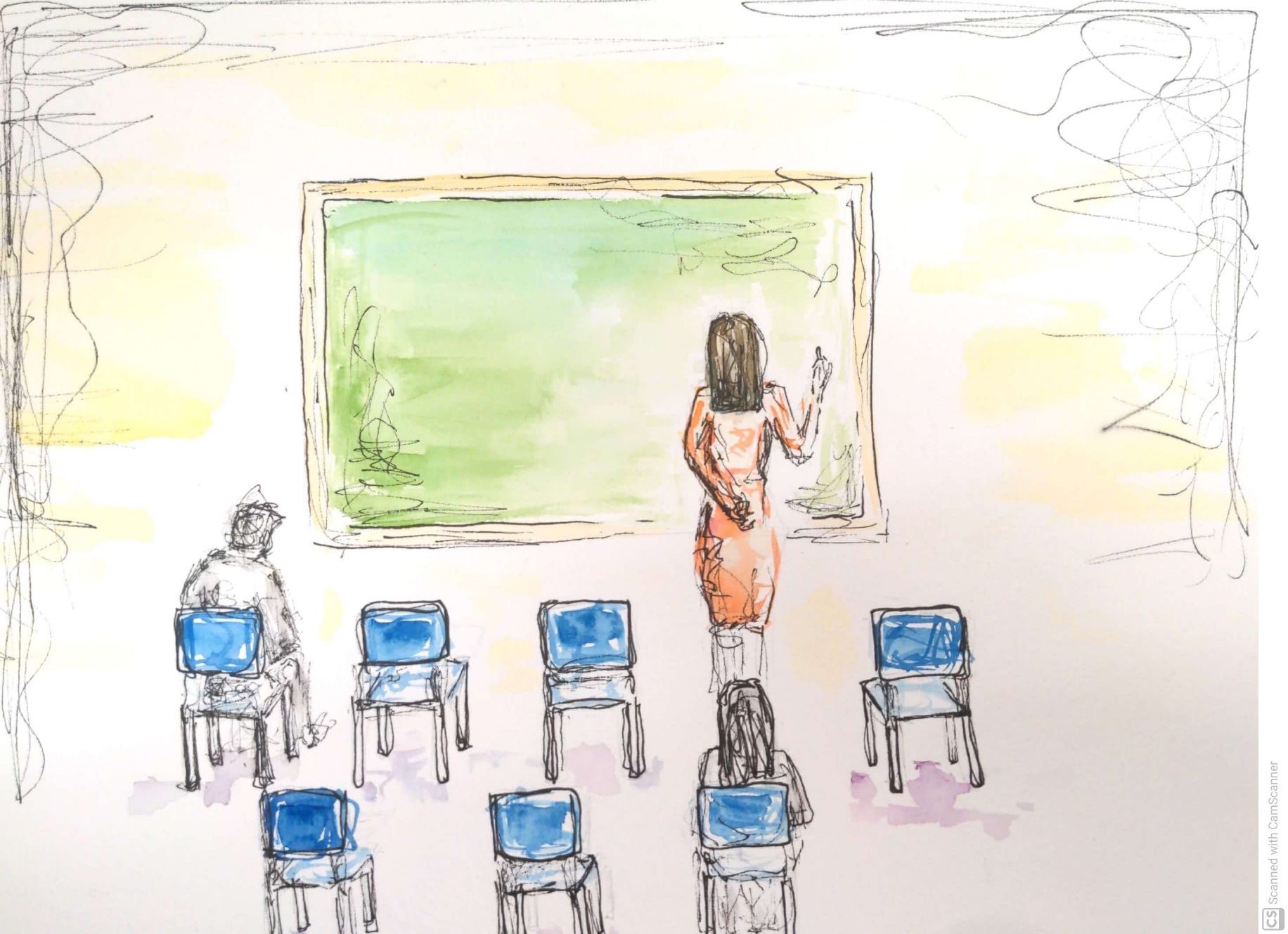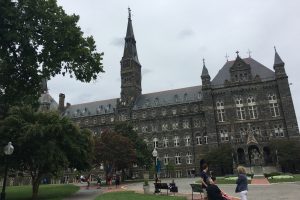After returning to campus after a year-long leave of absence, I have spent the last two months wondering how long it will take to restore my personal sense of normalcy.
While COVID-era protocols have changed campus in ways that are impossible to ignore, I have been in search of the rhythm that was inherent to my pre-pandemic Georgetown experience: I was excited to live on campus and see my friends for the first time in a year and a half, take classes that interest me, and settle into a routine no longer entirely defined by a public health crisis.
As it turns out, Georgetown’s sense of normalcy isn’t characterized by sustained relationships and genuine academic engagement, but rather by faculty and administrators’ continued disregard for student health.
On Sep. 30, the Provost emailed students to inform them that they should not expect to “participate synchronously (i.e., Zoom) in a class designated as in-person,” or assume that they “may miss class and make up the material asynchronously without an approved reason for doing so.”
This email came less than a week after the university announced the presence of norovirus on campus. When the email was sent, a total of 145 students had reported symptoms of a gastrointestinal illness, some of which had been confirmed as norovirus. At that point, the virus was merely one illness making its way around campus alongside COVID, strep, flu, and the common cold.
Naturally, a myriad of illnesses traveling across campus often results in many students missing class. While an earlier email from the university stated that students would not need to provide a doctor’s note for medical-related absences, the aggressive and insensitive sentiments in the Sep. 30 email imply that this was no longer true. And because Georgetown is committed to maintaining in-person learning, professors are not required to create ongoing virtual class options.
Of course, professors are supposed to accommodate for COVID-related absences; considering the methods of accommodation are up to individual professors, however, these accommodations can be far-ranging and often inadequate. So far, student testimonies of class policies and formats have proved the insufficiency of current structures.
This lack of alternate class options leaves sick students to choose between missing class entirely or potentially infecting other students by attending; with the presence of various illnesses on campus, students have been forced to frequently contemplate this decision.
While the administration’s encouragement of strict attendance policies is newly infuriating, it is a longstanding issue that has only been exacerbated by the pandemic.
Professors have long enacted policies that restrict the number of absences allowed in their classes. It’s common for syllabi to include a set number of unexcused absences allowable without having an impact on students’ grades. Oftentimes, after students “use up” the established number of absences, points will be deducted from their final grade in the class.
Limiting the number of absences per semester often necessitates—and in turn, normalizes— attending class while sick. For a long time, entering a classroom and being surrounded with students coughing or sneezing has been a frequent occurrence. Students have long been told that our studies are more important than our health, resulting in an almost constant deterioration of our bodies and minds in favor of getting good grades.
Now more than ever, students should not feel pressured to attend class when they are not feeling well. Additionally, students should not need to provide documentation for their absences. Sometimes, students have a cold and need to take DayQuil. Sometimes, students wake up feeling depressed and need to lay in bed all day. We shouldn’t feel like these reasons are invalid simply because they cannot be supported by a piece of paper.
Not mandating documentation is especially important for low-income and disabled students, considering documents can be incredibly inaccessible.
Obtaining documentation can be costly—especially if students have other expenses to worry about. Even with insurance, most visits to the student health center require a copayment of around $25. While $25 might not seem like a lot to many Georgetown students, for those who are low-income, it is a substantial cost—and one that can be avoided with over-the-counter medication and rest. If we require a doctor’s note to document an absence, are we making students pay to miss class?
Necessitating documentation is also difficult for disabled students, especially those with chronic illnesses or psychiatric disabilities, who cannot predict when they may need to miss class.
The simple solution to this may seem to be applying for accommodations—however, this isn’t always as easy as it sounds.
Through the Academic Resource Center (ARC), students can apply for academic accommodations, such as extra time on tests, assignment extensions, or flexible class attendance. To obtain accommodations, students must submit documentation of their disability, which includes proof that “substantiates the limitation on a major life activity as a result of the disability.” After a 2–4 week wait, students must meet with an administrator from the ARC, as well as with professors or academic deans to discuss the implementation of their accommodations.
The ARC’s accommodations process may seem lengthy and annoying at worst. In reality, it is a textbook case of forced intimacy, in which disabled students are expected to disclose personal details of their disability just to obtain bare-minimum accommodations.
And many times, these accommodations are not even respected. Since accommodations are implemented on a case-by-case basis, even documented access needs can be disregarded or flat-out rejected.
Between the red tape, the forced intimacy in the application process, and the uncertainty of implementation, trying to obtain accommodations can be even more strenuous. As a disabled student myself, I have opted out of applying for accommodations that I genuinely need because the process seems to regularly produce more harm than good.
Instead I have been relying on the hope that my professors will be at least somewhat understanding. This has been especially true this semester, while we attempt to conduct our first entirely in-person semester since the start of the pandemic. After teaching classes entirely online for a year and a half, it seems more than possible for professors to create accessible class options.
Unfortunately, not all professors have taken advantage of this possibility. Although faculty seemed to be slightly more flexible during virtual learning, the return to in-person classes has been accompanied by the return of strict attendance policies.
This issue seems to partially stem from the lack of an overarching university policy regarding virtual and hybrid class options. The administration has made it clear that all decisions regarding course formats, attendance policies, and continuity plans are up to individual professors. This lack of cohesiveness has only led to a lack of accountability, which has resulted in many professors creating restrictive attendance policies that show a clear disregard for public health.
Not having a universal policy for virtual course options is especially frustrating considering recent technology updates can accommodate students who must attend classes virtually. Many classrooms now have cameras and microphones that let professors stream class over Zoom while simultaneously teaching in-person. Why would Georgetown spend so much money on technology if it isn’t being utilized?
Considering how long disabled people have been advocating for these very accommodations, the commitment to limited absences and rigid course options is even more exasperating. Before COVID, it was rare to see events held virtually or for classes to have hybrid options. Despite all of the harm that the pandemic has brought to disabled communities, it provided some hope for the future of access in education. It became clear that accommodations involving virtual or asynchronous participation are, in fact, possible, despite what many disabled students have long been told.
Now that schools have reopened and students have returned to campus, the fading of these accommodations feels like a reminder that some people do not have to think about access needs beyond existing structures.
As we continue to navigate in-person education during the pandemic, we must realize that a “return to normal” cannot mean a return to inaccessible, ableist structures. These structures will only continue to harm students and contribute to further problems. Instead, we must work to implement accessible course features, including hybrid formats and options for flexible/asynchronous attendance. These measures are not only essential to sustaining students throughout pandemic learning, but also long overdue.





